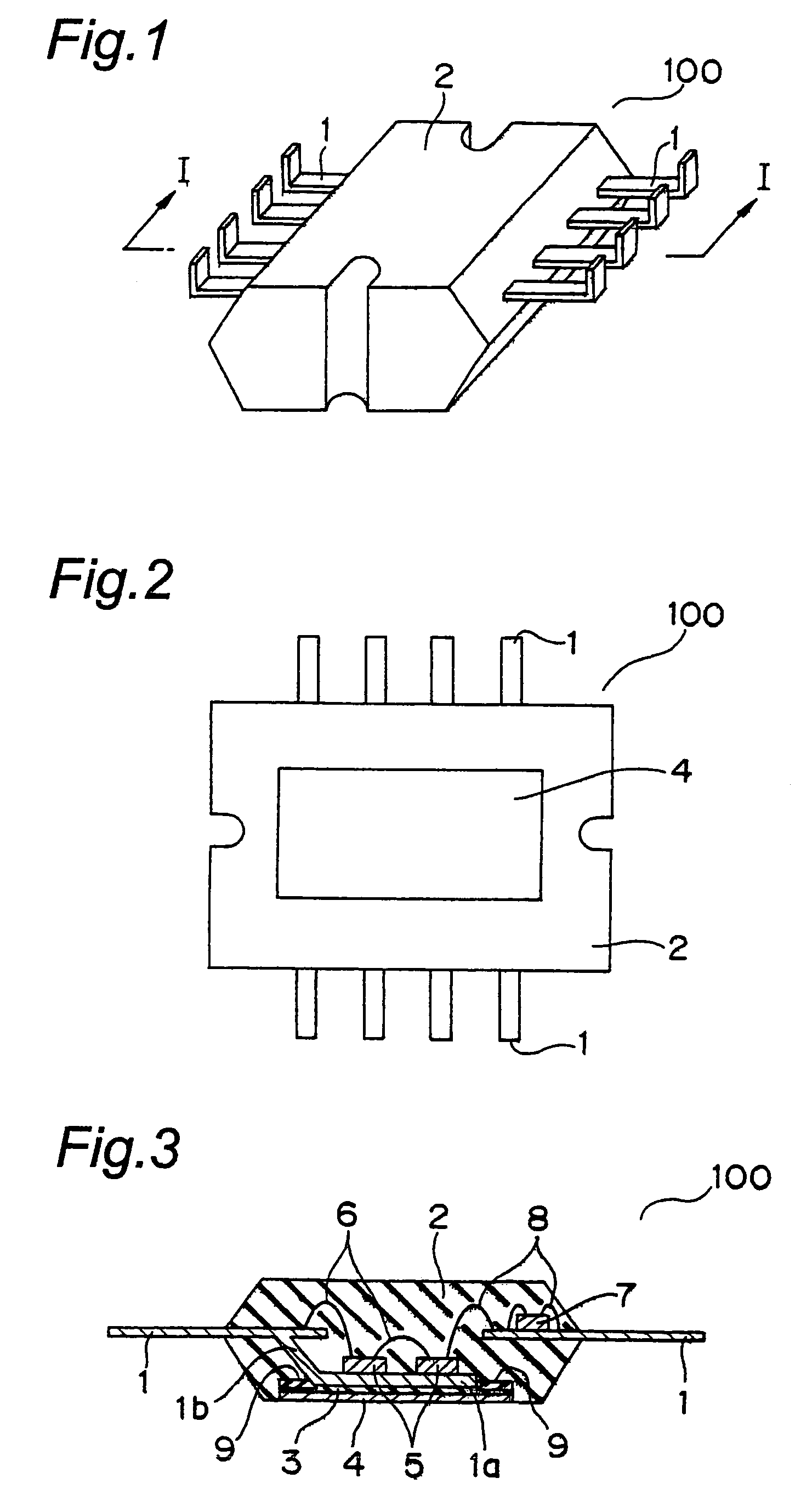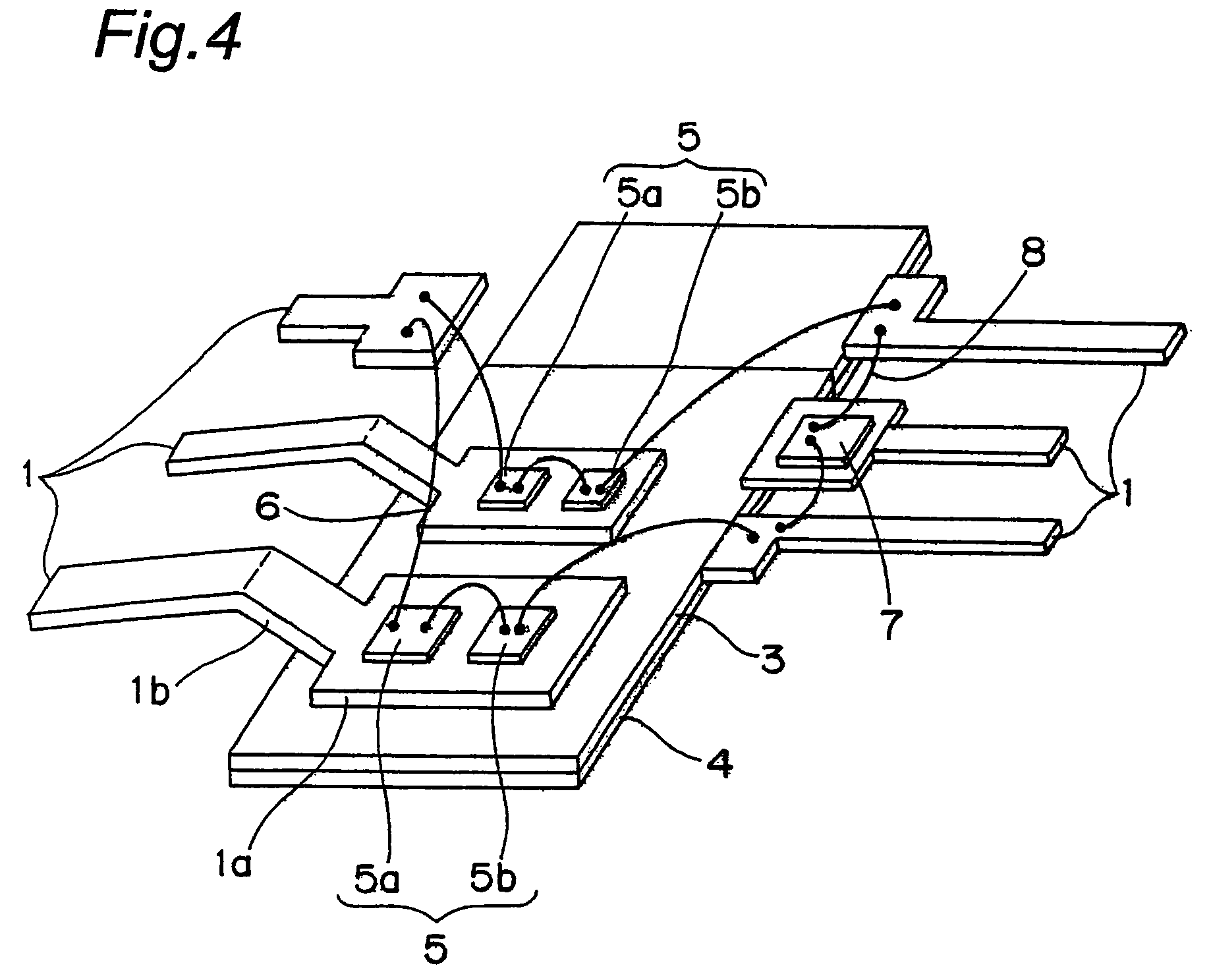Semiconductor device and method for producing the same
a semiconductor device and semiconductor technology, applied in semiconductor devices, semiconductor/solid-state device details, electrical devices, etc., can solve the problems of reducing the thickness of the resin disposed in these portions, deteriorating an insulating property, and the size of the semiconductor device therefore increasing, so as to enhance the heat dissipation property and the effect of increasing the size of the semiconductor devi
- Summary
- Abstract
- Description
- Claims
- Application Information
AI Technical Summary
Benefits of technology
Problems solved by technology
Method used
Image
Examples
embodiment 1
[0021]FIG. 1 is a perspective view of a semiconductor device according to this embodiment of the present invention generally denoted at 100. FIG. 2 is a back surface view of the semiconductor device 100 of FIG. 1 while FIG. 3 is a cross sectional view of the semiconductor device 100 of FIG. 1, both taken along the direction I-I. FIG. 4 is a perspective view which shows a portion inside the semiconductor device 100 of FIG. 1.
[0022]As shown in FIG. 1, the semiconductor device 100 has a resin-molded package structure and includes a mold resin 2 on the both sides of which a plurality of metal frames 1 are disposed. The mold resin 2 is preferably of an epoxy resin.
[0023]As shown in FIG. 2, to the back surface of the mold resin 2, an insulation resin sheet 3 is disposed whose back surface seats a metal foil 4 of copper for instance. The insulation resin sheet 3 is preferably of an epoxy resin containing fillers. The fillers are made of one or materials selected from Sio2, Al2O3, AlN, Si3N...
embodiment 2
[0056]FIG. 7 is a cross sectional view of a semiconductor device according to this embodiment of the present invention generally denoted at 200. FIG. 7 is a cross sectional view taken along the same direction as the direction I-I shown in FIG. 1. In FIG. 7, the same reference symbols as those in FIGS. 1-3 denote the same or corresponding portions.
[0057]In the semiconductor device 200 according to the embodiment 2, the resin sheet 3 seating the metal foil 4 has such a size which covers the entire back surface of the mold resin 2. The semiconductor device is otherwise the same in structure as the semiconductor device 100 described above.
[0058]The semiconductor device 200 exhibits an enhanced heat dissipation property, and does not require positioning of the resin sheet 3 at the producing steps (the step 4 described above). In other words, since the resin sheet 3 has the same size as that of an inner bottom surface of the resin-sealing metal mold 20, it is not necessary to precisely co...
embodiment 3
[0059]FIG. 8 is a back surface view of a semiconductor device according to this embodiment of the present invention generally denoted at 300. FIG. 9 is a cross sectional view taken along the direction IIIV-IIIV of FIG. 8. In FIGS. 8 and 9, the same reference symbols as those in FIGS. 1-3 denote the same or corresponding portions.
[0060]The semiconductor device 300 includes a plurality of concave portions 40 around the sheet resin 3. Further, screw holes 35 are formed which are for attaching a cooling fin (not shown).
[0061]The concave portions 40 are created in the resin sheet 3 as a plurality of projections (not shown) are formed in the inner bottom surface of the metal mold 20 at the step 4 described above (FIG. 5D) for the purpose of making the positioning easy. In the inner bottom surface of the metal mold 20, the projections are disposed along the area where the resin sheet 3 is disposed.
[0062]The projections disposed in the inner bottom surface of the metal mold 20 thus makes th...
PUM
 Login to View More
Login to View More Abstract
Description
Claims
Application Information
 Login to View More
Login to View More - R&D
- Intellectual Property
- Life Sciences
- Materials
- Tech Scout
- Unparalleled Data Quality
- Higher Quality Content
- 60% Fewer Hallucinations
Browse by: Latest US Patents, China's latest patents, Technical Efficacy Thesaurus, Application Domain, Technology Topic, Popular Technical Reports.
© 2025 PatSnap. All rights reserved.Legal|Privacy policy|Modern Slavery Act Transparency Statement|Sitemap|About US| Contact US: help@patsnap.com



